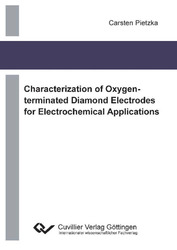| Departments | |
|---|---|
| Book Series (96) |
1378
|
| Nachhaltigkeit |
3
|
| Gesundheitswesen |
1
|
| Humanities |
2364
|
| Natural Sciences |
5406
|
| Mathematics | 229 |
| Informatics | 319 |
| Physics | 980 |
| Chemistry | 1363 |
| Geosciences | 131 |
| Human medicine | 243 |
| Stomatology | 10 |
| Veterinary medicine | 108 |
| Pharmacy | 147 |
| Biology | 835 |
| Biochemistry, molecular biology, gene technology | 121 |
| Biophysics | 25 |
| Domestic and nutritional science | 45 |
| Agricultural science | 1004 |
| Forest science | 201 |
| Horticultural science | 20 |
| Environmental research, ecology and landscape conservation | 148 |
| Engineering |
1793
|
| Common |
98
|
|
Leitlinien Unfallchirurgie
5. Auflage bestellen |
|
Advanced Search
Characterization of Oxygen-terminated Diamond Electrodes for Electrochemical Applications (English shop)
Carsten Pietzka (Author)Preview
Table of Contents, Datei (56 KB)
Extract, Datei (140 KB)
The topic of this thesis is the electrochemical characterization of oxygen-terminated single-crystal- and nanocrystalline diamond electrodes. Diamond is a very attractive material for bio- and electrochemical applications due to its exceptional stability, its biocompatibility, and its electrochemical properties like wide potential window of water dissociation and low background current. Therefore, diamond electrodes can operate even in harsh environments and under strongly oxidizing conditions, where electrochemical devices based on silicon or metals are corroded. Such applications can be e.g. pH sensing in strong acids and bases or the detection of organic molecules.
However, the electrochemical characterisitcs of oxygen-terminated diamond electrodes are dependent on the surface oxidation treatment. This issue was investigated within this thesis using electrochemical measurement techniques like cyclic voltammetry or electrochemical impedance spectroscopy. The results were be correlated with the analysis of X-ray photoemission (XPS) measurements.
The XPS measurements showed that different oxidation treatments induced different carbon-oxygen surface groups on the diamond surface. Besides, plasma oxidation treatments could induce a significant amount of non-diamond phases in the surface-near region.
The electrochemcial measurements showed typical behaviour of oxygen-terminated diamond electrodes like a potential window of 3.0 – 3.5 V and low background currents within this window both for single-crystal and nanocrystalline diamond. However, the adsorption characterisitcs in cyclic voltammetry and the value of the electronic surface barrier in contact to the electrolyte were dependent on the chose of the oxidation treatment. The electronic surface barrier ranged from approx. 1.0 eV to 1.8 eV depending on the carbon-oxygen bonds and the amount of sp2-like defects. In addition, a severe plasma treatment including argon bombardement induced a non-diamond layer of several monolayers on the electrode surface. This layer could be removed by annealing in hydrogen plasma at approx. 700 °C, as shown by XPS and electrochemical measurements.
Within this thesis, possible applications of diamond were introduced: It was shown that diamond electrodes can be used for the detection of ethanol at high anodic conditions. Besides, a promising electrode concept could be the fabrication of microelectrode arrays for high signal-to-noise ratios.
Finally, this work gives also an overview about the electrochemical characterisitcs of gallium nitride and indium nitride electrodes. Such III-nitride electrodes are also considered to be relative inert and therefore promising for electrochemical applications. However, it was shown that these materials are not fully stable under high anodic potentials. This shows that diamond is indeed the best electrode material for the operation under extreme conditions.
| ISBN-13 (Printausgabe) | 3869557095 |
| ISBN-13 (Hard Copy) | 9783869557090 |
| ISBN-13 (eBook) | 9783736937093 |
| Final Book Format | A5 |
| Language | English |
| Page Number | 142 |
| Lamination of Cover | glossy |
| Edition | 1 Aufl. |
| Volume | 0 |
| Publication Place | Göttingen |
| Place of Dissertation | Universität Ulm |
| Publication Date | 2011-04-07 |
| General Categorization | Dissertation |
| Departments |
Physics
Electrical engineering |
| Keywords | diamond electrode, electrochemical sensors, oxygen termination, impedance spectroscopy |








